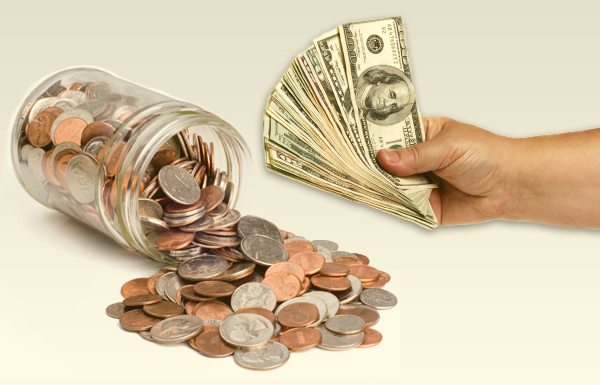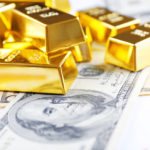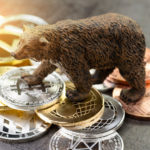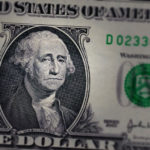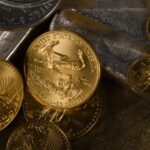How do I find out what my old coins are worth?
Answers to some common questions about coins and their value
-
What makes coins valuable?
-
What determines the value of coins?
-
How do I find out the value of my coins?
-
How do I sell my coins for the full value?
1. What makes coins valuable?
Metal – All things being equal, Gold and Silver coins are worth more than Nickel or Copper coins. Many coins are made out of precious materials like silver, gold, or platinum. These coin values can be less volatile because the worth is partially guaranteed by the metal content. A gold bullion coin, for example, is usually worth more than its melted weight, but it is never going to be worth much less than the melt content.
Country – American coins tend to be more popular and valuable with U.S. Dealers, Investors, and Collectors. However, there are some coins in demand by U.S. Dealers and Investors from Sovereign nations that are highly popular with both investors and collectors such as the Canadian Maple Leaf, British Sovereigns, French Roosters and Angels, etc.
Denomination – Generally speaking, for U.S. coins the higher the denomination, the more valuable the precious the metal used to produce the coin. For example: pennies are made of copper; $1 pieces are generally made of silver or gold; $20 and $50 pieces are gold; $100 usually are platinum.
Rarity – As a general rule, old coins are not necessarily rare. There are many ancient coins (coins over 1,500 years old) that aren’t worth more than a couple dollars because there are hundreds or thousands of them in existence. However, a 1913 Liberty Nickel, which is less the 100 years old, is worth over $1,000,000.00 because there are only five known to exist.
Demand – The demand for the particular coin, or how many investors/collectors want it, will greatly influence coin value. Some coins that are relatively plentiful may command higher prices than rarer coins because they are simply more popular with collectors. For example, there are over 400,000 1916-D dimes in existence as compared to only about 30,000 1798 dimes. However, even though the 1798 dime is much rarer than its 1916-D counterpart, the 1916-D coin sells for significantly more because many more people collecting early 20th century mercury dimes than dimes from the 1700’s. And even among coins with a similar number of copies in existence, some have a higher worth than others. This is because some coins are in higher demand, driving up the coin values. Coins may become popular because they are particularly lovely to look at, part of a popular set, or because they have a certain historical significance.
2. What determines the value of coins?
Authenticity - The fact is, significant numbers of counterfeit coins are sold as authentic coins by unscrupulous people to uninformed buyers. The large numbers of fakes made in China makes this a particularly challenging problem today. Fake coins are worth far less than their authentic counterparts, if they have any worth at all.
Altered or Cleaned - Cleaning a coin sharply reduces its collectible value! Once a coin has been cleaned, it will discolor much more quickly, requiring fresh cleaning. Each time it is cleaned, the surface is further dulled, reducing the coin’s appeal and reducing its value. Obviously this advice applies especially to uncirculated and proof coins, but it applies to any coin that is, or has, the potential to become valuable. Cleaned coins are rarely worth more than the melt value of the metal contained in the coin!
Year and Mint Mark – The year and mint mark of a coin go a long way in determining value. There are many year/mint combinations of various coins that are either extremely popular with collectors or extremely rare (low population). Coins in either of these categories are more valuable than year/mint combinations with relatively large populations (number of certified coins in existence today) or those with very low collector demand. For example: in the $20 Saint Gaudens series, a 1920 Philadelphia (1920) Saint has a population of 5440, yet that same year, a San Francisco (1920-S) minted Saint has a population of only 85, making the 1920-S far more valuable than the 1920.
Condition – The final major factor in determining coin values is the grade or condition of the coin. The more wear and tear that a coin has undergone, the less value it is going to have. This is why uncirculated coins are usually more valuable than coins that have been passed from hand to hand. Uncirculated coins have always been kept in the very best of conditions, making their value much higher. A coin in flawless condition may be worth hundreds of times more than a low-grade version of the exact same coin. Individual coins that are above average in appearance for strike, luster, color, toning, and eye appeal are considered to be higher in quality and in greater demand than those that do not look as nice. Basically, the better the condition of the coin, the more valuable it is than its counterpart (another coin in the same series from the same year and mint). Additional features can also add to, or detract from, the value of a coin. Things such as a strong strike, toning, and vibrant original luster can all add value; whereas things such as copper spots or a weak strike can sometimes lower the value.
Grade – Coins graded and encapsulated by a reputable, top tier grading service (such as PCGS or NGC) can generally command a better price than non-graded (raw) coins depending on the grade. Third party grading services issue grades to coins based on the Sheldon Scale. The Sheldon Scale is an alpha-numeric grade that describes the condition of the coin to the numismatic community. Numeric grades range from 1-70 (with 70 being perfect) and each numeric grade is preceded by one or two alphabetic characters (which represent the general category the coin falls in to.) Grading categories are designated by an alpha character. Alphabetical grading categories, in order from worst (P) to best (MS) are: P (Poor), F (Fair), AG (About Good), G (Good), VG (Very Good), F (Fine), VF (Very Fine), EF (Extra Fine), AU (About Uncirculated), BU (Brilliant Uncirculated), MS (Mint State). To a novice collector, the term ‘Extra Fine’ may sound more intriguing than ‘About Uncirculated’, but referring to the grading categories you’ve just learned, the fact is that AU coins will always command a higher price than their lesser graded counterparts! (i.e., alpha grades further down the scale: P, F, AG, G, VG, VF, and EF) Example #1: you have two Saint Gaudens $20 Gold Double Eagles, both from the 1912 Philadelphia mintage, one graded EF45 the other graded MS63; the MS63 will have greater value than its EF45 counterpart. For coins graded in the same category, the numeric grade then takes precedence. Example #2: you have two Morgan Silver Dollars, both from the 1882 New Orleans mintage (1882-O), one graded MS61, the other MS67; the MS67 will have greater value than the MS61.
If you wish to learn more, please visit ourInvestor Education center and click on ’Investor Education’ in the upper right menu. You’ll find lots of information on coin collecting, valuing your coins, investing in coins, understanding coin grading, and much more!
Quality - And obviously, all coins are not aesthetically equal. Some coin designs -- the high relief Saint-Gaudens Double Eagle, for example -- are widely considered to be more beautiful than others. The public’s taste for these designs has a significant influence on the value of the coins that bear them. The same goes for graded (certified) coins, generally speaking, the higher the grade the more valuable the coin than its lower graded counterpart. However, some coins grade at the top of their rating while others grade at the bottom, even though they are identical on paper. These differences within grade are usually small but nonetheless observable to the expert eye, and are an important factor in quality and value. Coins that are higher in quality always sell faster and usually command higher prices. The quality of your rare coins is therefore quite important, not merely for your own aesthetic enjoyment, but also for the value and liquidity of your investment.
3. How do I find out the value of my coins?
There are numerous sources of information to help you determine the value of your coins. Reputable coin dealers, Coin Auctions, eBay, and Price Guides are great places to start. If your coins are graded by one of the Top Tier grading services like PCGS or NGC, you can usually get a reasonable value estimate sight-unseen! If your coins are not graded, or have been graded/certified by a company other than PCGS or NGC, you should contact a reputable coin dealer or attend a coin show to help determine the value. The Top Tier Grading Services, PCGS and NGC, grade over 90% of all investment or collectible coins and as a result of their strict standards and upstanding reputations, they are both widely respected throughout the numismatic community.
FINDING A REPUTABLE COIN DEALER
The best coin dealer is a major market wholesaler with a minimum of ten years experience in the rare and investment coins business, with a proven track record of building profitable precious metal portfolios and an excellent industry reputation in numismatics and/or investment strategies.
Seven criteria for finding a reputable coin dealer:
1. Minimum ten years experience as a major market maker posting buy/sell prices for coins
2. Member of PNG for at least 5 years
The PNG (Professional Numismatic Guild) www.pngdealers.com is a private members-only association of reputable numismatic dealers that must be voted in by the membership to join. They must be well known and respected by the numismatic industry to even be considered for membership. Mint State Gold is proud to have our founder, Barry Stuppler, as the current 2017-2019 President of the Professional Numismatists Guild.
3. An informative website --- ideally with an investment guide section on buying and selling rare and investment coins and precious metals including things like portfolio building tips, how to buy, how to find a reputable dealer, investment strategies, etc.
4. NO COMMISSIONED TELEMARKETING SALESMAN- IMPORTANT FACT: Many commissioned telemarketers are new to the coin and bullion industry and do not have the experience to provide good advice. Their commission is added to your sales price, plus in many cases he/she is directed to sell the product of the day, rather than what you really need.
5. The dealer must be willing to disclose their profit margin and buy/sell pricing.
6. Knowledgeable and Available --- offer you current numismatic industry news and pricing information; complete and full disclosure; the ability to quickly and easily answer your questions about investing in coins or precious metals; and free investment and portfolio building consultations and investing strategies.
Choosing the right coin dealer requires investing your time, but it is time well spent. Spend the time and give due diligence to checking out the coin dealer! Knowing the dealer is credible, knowledgeable, fair, and honest are of the utmost importance before conducting any transactions.
LOCAL COIN SHOPS OR COIN SHOWS
You may find local coin stores or even coin shows near you. Again, PLEASE USE DUE DILIGENCE and follow the guidelines above for FINDING A REPUTABLE DEALER. This may sound redundant, but this cannot be emphasized enough.
COIN AUCTIONS
Here are a few of the major Coin Auction Houses.
Heritage https://coins.ha.com/
Stack’s www.stacks.com/Auction/Auctions
Bowers & Merena www.bowersandmerena.com/
EBAY AUCTIONS – Ebay has a very active coin market… however…. There are a few tips for finding fairly ACCURATE coin values through ebay auction results:
1. Search COMPLETED listings that HAVE RECEIVED BIDS – many people LIST a coin for a specific amount but it never sells. Searching Active eBay Listings will only show you what people (many without any background in numismatics) hope to get for their coins. COMPLETED listings will show you what someone was actually willing to PAY for the coin.
2. Check the seller feedback – if you find that the seller has negative feedback, less than 2,000 feedbacks, or have been on ebay for less than 3 years, they could be running some type of a scam or even selling counterfeit coins! These values should not be taken into consideration when determining the value your coins.
PRICING GUIDES
There are also numerous coin pricing guides available both online and in printed form. Remember that the printed pricing guides (i.e. The Red Book) went to print at least 6 months prior to the publication date and coin values have more than likely changed since the book went to press. Printed price guides can help give you a general idea of the value of your coins, but for the most current and accurate value we do not recommend using printed price guides.
Online coin pricing guides may be a bit more up-to-date than printed guides, but are only as accurate, current, or reliable as the company or individual publishing the online guide. Online coin pricing guides may or may not be a true determination of the actual value of your coins. It is always wise to verify any coin values obtained from a printed or online pricing guide with a reputable coin dealer.
4. How do I sell my coins for their full value?
1. ORIGINAL SELLER - rare coins should first be offered to the original seller. If the original seller is not available, not interested, or you are not happy with their offer, then consider the additional options below.
2. REPUTABLE DEALERS – most coin dealers that sell coins also buy coins. If you have done your research and can TRUST your dealer, you can usually feel confident that you will receive fair value for your coins. Again, USE DUE DILIGENCE and follow the guidelines above for FINDING A REPUTABLE DEALER.
-
GRADED COINS (certified by PCGS or NGC)
Coins that have been Graded (or Certified) by either PCGS or NGC generally have an actively traded market and are very easy to sell. Coins should first be offered to the original seller. If the original seller is not available or interested, then high quality digital pictures (in .JPG format) of the holder and both sides of the coin would be required to offer them to another buyer/dealer. With good photos of both the front and back or your coin, and a brief description (Proof of Ownership, year, mint, denomination, type, attributes, special marking/coloring/toning, etc.) you can often submit them for a quote online (via a dealer’s website) or by email and even by postal mail (if you have printed copies of your photos). Most serious rare coin buyers can quote you a ballpark price if they wish to purchase your rare coins
-
UNCERTIFIED COINS – (or coins graded by a company other than NGC or PCGS)
Selling uncertified coins, or those graded by a company or individuals other than PCGS or NGC, can be a bit more problematic. Most reputable dealers will not offer you anything for uncertified coins sight unseen or simply from looking at photos. There are rare exceptions to this, but generally speaking, if your coins are uncertified you definitely need to find a reputable dealer and follow their procedure for coin submission and/or valuations.
-
SHIPPING YOUR RARE COINS - If shipping is required to sell your coins, ask the dealer for shipping information. It’s a good bet the dealer’s shipping/insurance costs would be better than yours if the dealer has a company insurance policy. For example, Mint State Gold provides our FedEx shipping and insurance information and price confirmation to sellers who are prepared to ship immediately.
-
PAYMENT - You should expect immediate payment upon delivery of your coins. If you are shipping the material, allow one business day for the buyer to mail, wire or FedEx payment.
3. EBAY – Ebay has a very active coin market and if you have great pictures and some free time to spare, you can possibly sell your coins on ebay.
4. CONTACT US – Mint State Gold buys coins, too! Just click the SELL TO US link and we can help!


